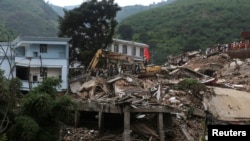The powerful earthquake that hit Southwest China earlier this month killed more than 600 people and flattened an estimated 22,500 homes. The tragedy has highlighted the difficulties China faces in extending safety standards for homes in remote areas of its countryside.
According to the China Earthquake Administration, most of the homes in the mountainous area of Yunnan, where the quake hit, were made of bricks, wood and mud walls.
They were too old and weak to resist an earthquake, the agency said in a statement.
As a result, the overwhelming majority of those killed in last week's 6.1 magnitude earthquake died under collapsed houses.
Long Enshen, a professor at the Sichuan University’s Institute of Disaster Management and Reconstruction, says a lack of resources is largely to blame.
“In recent years, previous earthquakes in Wenchuan or the one in Yan'an definitely had an impact on these areas and their awareness on anti-seismic construction has improved. But because of the economic conditions, many of the buildings [in rural areas] still lack in anti-seismic capacity,” says Long.
After a strong earthquake hit Wenchuan county in Sichuan province killing tens of thousands of people in 2008, China upgraded its anti-seismic standards and offered subsidies to residents of quake-prone areas to build sturdier homes.
But Chinese media have reported loopholes in the government's efforts.
In Yunnan, a local official told the Beijing-daily Xinjingbao that a provincial plan to renovate houses in the countryside had had little success in the six years since it was announced.
The official said that in Ludian county, where the quake hit last week, only 0.08 percent of homes had completed renovation.
Residents told the newspaper the subsidies they received were not enough to buy material, transport it to their village and pay a contractor's fees.
Edward Ng, a professor of architecture at the Chinese University of Hong Kong, has been working with local administrations in Sichuan to adopt different anti-seismic designs.
“With the amount of money that the government can subsidize you still have to find a way to design something that is cheap enough so that the subsidies will cover most of the cost, otherwise it still won't be able to be promoted on the market. You cannot design the kinds of earthquake houses that, for example, Japan is building for their domestic market,” he said.
In 2008, Ng helped rebuild a quake-hit village in Sichuan using local materials - including rubble from previously demolished homes.
The structures would withstand the quake's main shock, leaving residents a few hours to escape before the home collapsed.
Ng says local governments are open to these solutions.
“They can't solve the problem themselves, and the local villagers are crying out for help.”
The government has said it plans to extend anti-seismic standards to all buildings in China by 2020.
But analysts believe that while it is possible the government will be successful in cities, there are still enormous challenges for that goal to be realized in the countryside.
